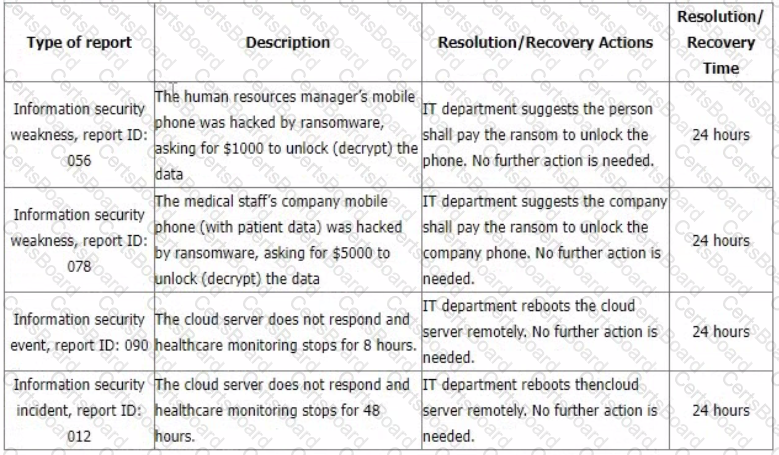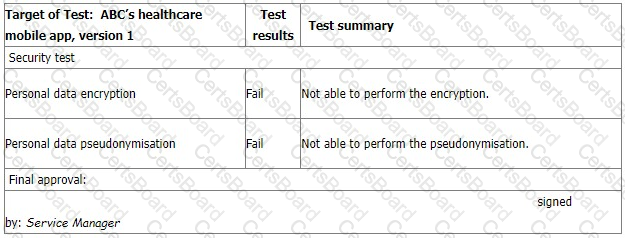You are performing an ISMS audit at a residential nursing home that provides healthcare services. The next step in your audit plan is to verify the information security incident management process. The IT Security Manager presents the information security incident management procedure and explains that the process is based on ISO/IEC 27035-1:2016.
You review the document and notice a statement "any information security weakness, event, and incident should be reported to the Point of Contact (PoC) within 1 hour after identification". When interviewing staff, you found that there were differences in the understanding of the meaning of "weakness, event, and incident".
You sample incident report records from the event tracking system for the last 6 months with summarized results in the following table.

You would like to further investigate other areas to collect more audit evidence. Select two options that will not be in your audit trail.
You are carrying out your first third-party ISMS surveillance audit as an Audit Team Leader. You are presently in the auditee's data centre with another member of your audit team.
You are currently in a large room that is subdivided into several smaller rooms, each of which has a numeric combination lock and swipe card reader on the door. You notice two external contractors using a swipe card and combination number provided by the centre's reception desk to gain access to a client's suite to carry out authorised electrical repairs.
You go to reception and ask to see the door access record for the client's suite. This indicates only one card was swiped. You ask the receptionist and they reply, "yes it's a common problem. We ask everyone to swipe their cards but with contractors especially, one tends to swipe and the rest simply 'tailgate' their way in" but we know who they are from the reception sign-in.
Based on the scenario above which one of the following actions would you now take?
An audit finding is the result of the evaluation of the collected audit evidence against audit criteria. Evaluate the following potential formats of audit evidence and select the two that are acceptable.
Scenario 5: Data Grid Inc. is a well-known company that delivers security services across the entire information technology infrastructure. It provides cybersecurity software, including endpoint security, firewalls, and antivirus software. For two decades, Data Grid Inc. has helped various companies secure their networks through advanced products and services. Having achieved reputation in the information and network security field, Data Grid Inc. decided to obtain the ISO/IEC 27001 certification to better secure its internal and customer assets and gain competitive advantage.
Data Grid Inc. appointed the audit team, who agreed on the terms of the audit mandate. In addition, Data Grid Inc. defined the audit scope, specified the audit criteria, and proposed to close the audit within five days. The audit team rejected Data Grid Inc.'s proposal to conduct the audit within five days, since the company has a large number of employees and complex processes. Data Grid Inc. insisted that they have planned to complete the audit within five days, so both parties agreed upon conducting the audit within the defined duration. The audit team followed a risk-based auditing approach.
To gain an overview of the main business processes and controls, the audit team accessed process descriptions and organizational charts. They were unable to perform a deeper analysis of the IT risks and controls because their access to the IT infrastructure and applications was restricted. However, the audit team stated that the risk that a significant defect could occur to Data Grid Inc.'s ISMS was low since most of the company's processes were automated. They therefore evaluated that the ISMS, as a whole, conforms to the standard requirements by asking the representatives of Data Grid Inc. the following questions:
•How are responsibilities for IT and IT controls defined and assigned?
•How does Data Grid Inc. assess whether the controls have achieved the desired results?
•What controls does Data Grid Inc. have in place to protect the operating environment and data from malicious software?
•Are firewall-related controls implemented?
Data Grid Inc.'s representatives provided sufficient and appropriate evidence to address all these questions.
The audit team leader drafted the audit conclusions and reported them to Data Grid Inc.'s top management. Though Data Grid Inc. was recommended for certification by the auditors, misunderstandings were raised between Data Grid Inc. and the certification body in regards to audit objectives. Data Grid Inc. stated that even though the audit objectives included the identification of areas for potential improvement, the audit team did not provide such information.
Based on this scenario, answer the following question:
Based on scenario 5, the audit team disagreed with the proposed audit duration by Data Grid Inc. for the ISMS audit. How do you describe such a situation?
You are performing an ISMS audit at a residential nursing home (ABC) that provides healthcare services. The next
step in your audit plan is to verify the information security of ABC's healthcare mobile app development, support,
and lifecycle process. During the audit, you learned the organization outsourced the mobile app development to a
professional software development company with CMMI Level 5, ITSM (ISO/IEC 20000-1), BCMS (ISO 22301) and
ISMS (ISO/IEC 27001) certified.
The IT Manager presented the software security management procedure and summarised the process as following:
The mobile app development shall adopt "security-by-design" and "security-by-default" principles, as a minimum.
The following security functions for personal data protection shall be available:
Access control.
Personal data encryption, i.e., Advanced Encryption Standard (AES) algorithm, key lengths: 256 bits; and
Personal data pseudonymization.
Vulnerability checked and no security backdoor
You sample the latest Mobile App Test report, details as follows:

The IT Manager explains the test results should be approved by him according to the software security management procedure. The reason why the encryption and pseudonymisation functions failed is that these functions heavily slowed down the system and service performance. An extra 150% of resources are needed to cover this. The Service Manager agreed that access control is good enough and acceptable. That's why the Service Manager signed the approval.
You are preparing the audit findings. Select the correct option.
You are an experienced ISMS audit team leader. You are providing an introduction to ISO/IEC 27001:2022 to a class of Quality Management System Auditors who are seeking to retrain to enable them to carry out information security management system audits.
You ask them which of the following characteristics of information does an information security management system seek to preserve?
Which three answers should they provide?
You are an experienced ISMS audit team leader who is currently conducting a third party initial certification audit of a new client, using ISO/IEC 27001:2022 as your criteria.
It is the afternoon of the second day of a 2-day audit, and you are just about to start writing your audit report. So far no nonconformities have been identified and you and your team have been impressed with both the site and the organisation's ISMS.
At this point, a member of your team approaches you and tells you that she has been unable to complete her assessment of leadership and commitment as she has spent too long reviewing the planning of changes.
Which one of the following actions will you take in response to this information?
Scenario 3: NightCore is a multinational technology company based in the United States that focuses on e-commerce, cloud computing, digital streaming, and artificial intelligence. After having an information security management system (ISMS) implemented for over 8 months, they contracted a certification body to conduct a third party audit in order to get certified against ISO/IEC 27001.
The certification body set up a team of seven auditors. Jack, the most experienced auditor, was assigned as the audit team leader. Over the years, he received many well known certifications, such as the ISO/IEC 27001 Lead Auditor, CISA, CISSP, and CISM.
Jack conducted thorough analyses on each phase of the ISMS audit, by studying and evaluating every information security requirement and control that was implemented by NightCore. During stage 2 audit. Jack detected several nonconformities. After comparing the number of purchased invoices for software licenses with the software inventory, Jack found out that the company has been using the illegal versions of a software for many computers. He decided to ask for an explanation from the top management about this nonconformity and see whether they were aware about this. His next step was to audit NightCore's IT Department. The top management assigned Tom, NightCore's system administrator, to act as a guide and accompany Jack and the audit team toward the inner workings of their system and their digital assets infrastructure.
While interviewing a member of the Department of Finance, the auditors discovered that the company had recently made some unusual large transactions to one of their consultants. After gathering all the necessary details regarding the transactions. Jack decided to directly interview the top management.
When discussing about the first nonconformity, the top management told Jack that they willingly decided to use a copied software over the original one since it was cheaper. Jack explained to the top management of NightCore that using illegal versions of software is against the requirements of ISO/IEC 27001 and the national laws and regulations. However, they seemed to be fine with it.
Several months after the audit, Jack sold some of NightCore's information that he collected during the audit for a huge amount of money to competitors of NightCore.
Based on this scenario, answer the following question:
What type of audit evidence has Jack collected when he identified the first nonconformity regarding the software? Refer to scenario 3.
You are an ISMS audit team leader tasked with conducting a follow-up audit at a client's data centre. Following two days on-site you conclude that of the original 12 minor and 1 major nonconformities that prompted the follow-up audit, only 1 minor nonconformity still remains outstanding.
Select four options for the actions you could take.


